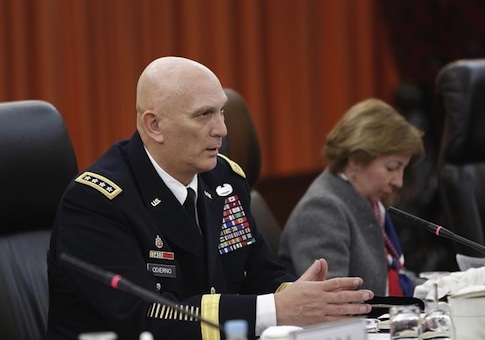By Andrea Shalal
WASHINGTON (Reuters) - The U.S. Army warned on Monday that mandatory budget cuts due to resume in fiscal 2016 would be devastating to a service that is already facing huge risks as it tries to keep forces ready for battle, replace aging equipment and respond to crises around the world.
"We have to have a national security debate ... because there is too much going on," U.S. Army Chief of Staff General Ray Odierno told reporters at the annual Association of the U.S. Army (AUSA) conference.
Odierno said the Army had agreed to further reduce the size of its active force to 450,000 troops from an earlier goal of 490,000 to comply with mandatory budget cuts known as sequestration, but he questioned if even the original target would allow the Army to respond as needed around the globe.
"The problem is that since we made those statements, the world is changing in front of us," Odierno said, citing Russian aggression in eastern Europe, growing threats from Islamic State militants and challenges in other areas.
"I now have concerns whether even the old level of 490,000 is the right thing to do because of what I see potentially on the horizon," he said, adding that it was critical to examine all possible options given the changing security environment.
Odierno said he believed air strikes were helping slow the spread of Islamic State extremists in Iraq and Syria, but it would be a long and difficult fight.
Army Secretary John McHugh told reporters that the Army had already made tough choices to delay and cancel weapons programs so it could achieve sequestration budget cuts, but further reductions would be very difficult to implement.
Top weapons makers like Lockheed Martin Corp and Boeing Co are watching the Army's budget debate with great interest given the dearth of new weapons programs available for industry to bid on.
McHugh said Americans relied on the U.S. military and the Army in particular to respond to a wide variety of threats, including the Ebola outbreak in Africa. But repeated budget cuts would limit the Army's ability to respond in a timely fashion.
"As we see our budget shrink, we are fiscally and physically unable to be in more and more places, which increases the response time," McHugh said.
Odierno said the Army had already cut its aviation units by 25 percent, which also limited its ability to respond to multiple crises around the world simultaneously.
"We have a huge window of risk in modernization and readiness," Odierno said. "We continue to increase the requirements and commitments of our forces, and yet we cannot ensure that we're going to have the readiness to meet those commitments."
(Reporting by Andrea Shalal; Editing by Jim Loney)
